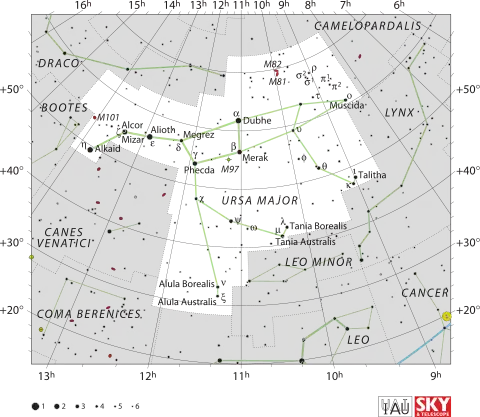Sigma1 Ursae Majoris
Sigma1 Ursae Majoris (σ1 UMa) is the Bayer designation for a solitary[8] star in the northern circumpolar constellation of Ursa Major. With an apparent visual magnitude of 5.14[2] it is faintly visible to the naked eye on dark nights. Based upon an annual parallax shift of 6.26 mas,[1] it is located roughly 520 light years from the Sun. At that distance, the visual magnitude of the star is diminished by an extinction factor of 0.06[3] due to interstellar dust.

| |
| Observation data Epoch J2000.0 Equinox J2000.0 (ICRS) | |
|---|---|
| Constellation | Ursa Major |
| Right ascension | 09h 08m 23.49946s[1] |
| Declination | +66° 52′ 23.6492″[1] |
| Apparent magnitude (V) | 5.14[2] |
| Characteristics | |
| Spectral type | K5 III[3] |
| U−B color index | +1.80[2] |
| B−V color index | +1.52[2] |
| Astrometry | |
| Radial velocity (Rv) | 14.60±0.19[4] km/s |
| Proper motion (μ) | RA: −22.68[1] mas/yr Dec.: −40.11[1] mas/yr |
| Parallax (π) | 6.26 ± 0.30[1] mas |
| Distance | 520 ± 20 ly (160 ± 8 pc) |
| Absolute magnitude (MV) | −0.93[3] |
| Details | |
| Radius | 46[5] R☉ |
| Luminosity | 560±20[3] L☉ |
| Surface gravity (log g) | 1.66[6] cgs |
| Temperature | 3,940[6] K |
| Metallicity [Fe/H] | −0.23[6] dex |
| Other designations | |
| Database references | |
| SIMBAD | data |
This is an evolved K-type giant star with a stellar classification of K5 III.[3] It is a suspected variable with an amplitude of 0.03 magnitude.[3] The measured angular diameter of the star after correcting for limb darkening is 2.67±0.04 mas,[9] which, at the estimated distance of this star, yields a physical size of about 46 times the radius of the Sun.[5] The star is radiating around 560[3] times the solar luminosity from its outer atmosphere at an effective temperature of 3,940 K.[6]
Naming
With π1, π2, σ2, ρ, A and d, it composed the Arabic asterism Al Ṭhibā᾽, the Gazelle.[10] According to the catalogue of stars in the Technical Memorandum 33-507 - A Reduced Star Catalog Containing 537 Named Stars, Al Ṭhibā were the title for seven stars : A as Althiba I, this star (π1) as Althiba II, π2 as Althiba III, ρ as Althiba IV, this star (σ1) as Althiba V, σ2 as Althiba VI, and d as Althiba VII.[11]
References
- van Leeuwen, F. (2007), "Validation of the new Hipparcos reduction", Astronomy and Astrophysics, 474 (2): 653–664, arXiv:0708.1752, Bibcode:2007A&A...474..653V, doi:10.1051/0004-6361:20078357, S2CID 18759600.
- Mermilliod, J.-C. (1986), "Compilation of Eggen's UBV data, transformed to UBV (unpublished)", Catalogue of Eggen's UBV Data, SIMBAD, Bibcode:1986EgUBV........0M.
- Groenewegen, M. A. T. (April 2012), "Infrared excess around nearby red giant branch stars and Reimers law", Astronomy & Astrophysics, 540: 21, Bibcode:2012A&A...540A..32G, doi:10.1051/0004-6361/201118287, A32.
- de Bruijne, J. H. J.; Eilers, A.-C. (October 2012), "Radial velocities for the HIPPARCOS-Gaia Hundred-Thousand-Proper-Motion project", Astronomy & Astrophysics, 546: 14, arXiv:1208.3048, Bibcode:2012A&A...546A..61D, doi:10.1051/0004-6361/201219219, S2CID 59451347, A61.
- Lang, Kenneth R. (2006), Astrophysical formulae, Astronomy and astrophysics library, 1 (3rd ed.), Birkhäuser, ISBN 3-540-29692-1. The radius (R*) is given by:
- Soubiran, C.; et al. (June 2010), "The PASTEL catalogue of stellar parameters", Astronomy and Astrophysics, 515: A111, arXiv:1004.1069, Bibcode:2010A&A...515A.111S, doi:10.1051/0004-6361/201014247, S2CID 118362423.
- "sig01 UMa". SIMBAD. Centre de données astronomiques de Strasbourg. Retrieved 2017-02-25.
- Eggleton, P. P.; Tokovinin, A. A. (September 2008), "A catalogue of multiplicity among bright stellar systems", Monthly Notices of the Royal Astronomical Society, 389 (2): 869–879, arXiv:0806.2878, Bibcode:2008MNRAS.389..869E, doi:10.1111/j.1365-2966.2008.13596.x, S2CID 14878976.
- Richichi, A.; et al. (February 2005), "CHARM2: An updated Catalog of High Angular Resolution Measurements", Astronomy and Astrophysics, 431 (2): 773–777, Bibcode:2005A&A...431..773R, doi:10.1051/0004-6361:20042039.
- Allen, Richard Hinckley (1899), Star-Names and Their Meanings, New York: G. E. Stechert, p. 444
- Rhoads, Jack W. (November 15, 1971), Technical Memorandum 33-507-A Reduced Star Catalog Containing 537 Named Stars (PDF), Jet Propulsion Laboratory, California Institute of Technology.